It’s now been 10 days since our ants were released from the nest. And I’ve come back to see how far the ant colony has come. The ant colony waste is of major consideration both for the scientists and the ants.
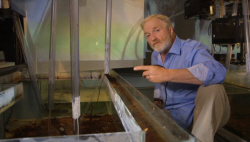
And straight away, I can see foraging trails now traverse the environment from end to end. The fungal gardens I saw last time have grown, and I can see some new ones too. Since they arrived in their new home, the ants have made real progress towards getting their society up and running again.
One of the best examples of this is at the very bottom of the nest.
Ant Colony Waste Dump
We are now in the bowels of the colony, right down below where all the ants have their nest chambers. And the reason we’re down here is that there’s a lot happening. The ants have the ant colony waste dump down here. All that leaf processing produces a lot of waste that needs to be dealt with. And ants cope with the trash burden in a similar way to us. This is an ant colony waste landfill.
Now, what we’ve got here is an ant colony waste dump they’ve made actually in the trough that surrounds the whole colony.
Ant Graveyard
And that’s the water-filled trough, which is designed to keep the ants in. What’s happened is, the ants have built a waste dump. And because it’s wet and the bacteria are building up in here, the smell of decaying ants and fungus is overpowering, it’s disgusting.
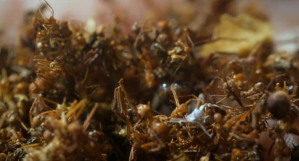
Normally, the dump is placed in chambers at the bottom of the colony where workers turn over the waste as a gardener does their flowerbeds. This speeds up the breakdown of potentially harmful substances.
But the ants aren’t just dumping the garbage down here, they are also disposing of dead bodies. Over on this side is the graveyard. Now, this is actually very interesting.
The ants, of course, don’t live for ever and when they die, their remains are taken down and dumped out of the colony.
And that in my hand is just dead remains of literally hundreds and hundreds of ants, of all castes, small workers, large workers, soldiers.
So, when the ants have no longer any function and when they die they are simply taken out and dumped.
The main reason why ants have to keep the waste and the dead remains of ants out of the way of the colony. Is that when you’re in such high abundances in the colony you don’t want any diseases to spread.
Disease-Free Ant Nest
So you have to maintain your environment, it has to be clean. Anything that could rot might cause disease. The waste dump is the destination for any such offending matter.
Seeing the dump and the graveyard really brings it home to me just how sophisticated the ant colony is. It’s easy to see why people have looked at the ants and thought they were seeing our own world reflected back.
We’ve even used the language of our own social structures to describe and society. Workers, soldiers, the Queen.
But, is ant society really organised with this kind of hierarchy? To answer that question, we need to take a closer look at the roles of the different ants in our colony, especially the Queen.
Tended round-the-clock by workers and fiercely protected by soldiers, she’s the colony’s most prized member. But does that mean she’s in charge?
Queen Ant
I can’t introduce you to our colony’s Queen because she’s deep in a chamber somewhere behind me, and I wouldn’t want to disturb her anyway.
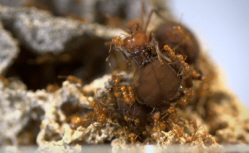
But Adam has brought a Queen from a much smaller colony and we can take a closer look at her.
Professor Adam Hart “So, what we’ve got here, George, is one that I dug out the ground in Trinidad. There is the Queen.”
I’ve never seen the Queen before like that.
Professor Adam Hart
Professor Adam Hart “She’s an impressive creature, she’s impressive in her own right, but when you see her next to the smaller ants it gives you an idea of how big she is.”
We can see the Queen’s enormous body protruding from the fungus, with smaller ants attending her. Inside her large abdomen are the ovaries that allow her to lay up to 30,000 eggs a day!
So, is the Queen in our colony roughly the same size?
Professor Adam Hart “Yeah, the Queen in our colony will be exactly like this. This is the same species from the same place.”
She’s a beautiful sort of velvety-brown colour?
Adam Hart “Yeah”
Ant Colony Waste
Our colony will only ever have one Queen in residence. But once a year, it will produce a new Queen who will leave the nest to start a new colony. This is also the only time the colony will produce males, and these males have one sole purpose – to mate.
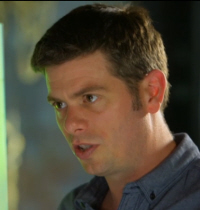
We have never observed the mating ritual of leafcutter ants in the wild. But, we can see how much of a large-scale operation this is with the British species, the wood ant.
In late summer, the colony produces hundreds of new queens and males. These ants have wings and the fly from the nest en masse to find a mate. This event is called the nuptial flight.
Nuptial Flight
Professor Adam Hart “These winged individuals are the females, the new queens, the males that they’ll mate with. It is a very effective way of dispersing not just mating with individuals from another colony, but also spreading out and spreading the colony far and wide.”
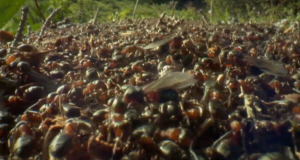
After the nuptial flight, the males simply die. The Queen will never mate again. She’s now ready to start a new colony. From now on, her role is to lay eggs. It’s a staggering thought that all the ants in our colony have the same mother.
The colony produces male ants during the mating period only. Otherwise, all ants are female, effectively sisters.
And there is something else that’s intriguing here. All the eggs the Queen lays are essentially the same. So how can they become all the different kinds of ant that make up the colony?
Worker Ant Nurse
Professor Adam Hart “The workers are in control of what goes on . because when the Queen lays eggs, she doesn’t lay an egg for a minor worker, or a soldier, and an egg for a Queen, she just lays an egg. The quantity and type of food a larva is fed will determine the type of ant it becomes.
So the workers who feed the larva they are actually controlling the number of soldiers and worker castes produced within the colony.
Professor Adam Hart “They’re really flexible and dynamic and can respond to what’s going on in the environment. So if we start disturbing this colony, they’ll start producing more soldiers.”
And it’s happening right in here now?
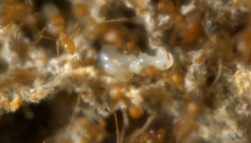
Professor Adam Hart “It’s happening right here, all over these fungus gardens. They are rearing these workers up within these fungus gardens and they’re responding to what’s going on.
Responding to the lights, responding to the heat, and to the food. They are responding to what the queen’s doing in terms of how many eggs she is laying.
And, somehow it is the workers that integrate all that information. This colony is all about the workers. It’s not really about the queen, she’s just popping out eggs.”
External Links
Ant Colony Waste makes the news – National Geographic
The Leafcutter Ants: Civilization by Instinct
Biological and Embryological Studies on Formicidae
